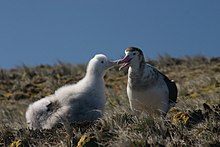Amsterdam albatross
| Amsterdam albatross | |
|---|---|

| |
| Adult in flight | |

| |
| Amsterdam albatross feeding chick | |
| Scientific classification | |
| Domain: | Eukaryota |
| Kingdom: | Animalia |
| Phylum: | Chordata |
| Class: | Aves |
| Order: | Procellariiformes |
| Family: | Diomedeidae |
| Genus: | Diomedea |
| Species: | D. amsterdamensis
|
| Binomial name | |
| Diomedea amsterdamensis | |
| Synonyms | |
|
Diomedea exulans amsterdamensis | |
The Amsterdam albatross or Amsterdam Island albatross,
Taxonomy
Albatrosses belong to the family
The scientific name Diomedea amsterdamensis is composed of Diomedea, from the marooned Greek hero Diomedes, whose companions were turned to birds,[8] and amsterdamensis, a Latin form of the name of the island where they are found.
Description
The Amsterdam albatross is a great albatross that breeds in brown, rather than in the more usual white, plumage. This bird weighs 4.8 to 8 kg (11–18 lb) and is 107 to 122 cm (42–48 in) long with a wingspan of 280 to 340 cm (110–130 in).[9] [10] The adult bird has chocolate brown upper parts and is white on its face mask, throat, lower breast, and belly. It has a broad brown breast band along with brown undertail coverts. Its pink bill has a dark tip and dark cutting edges, and finally, its underwings are white except for the dark tip and the dark leading edge.[11]
Distribution and habitat
The Amsterdam albatross breeds only on
Behaviour
Because of its rarity, the feeding ecology and at-sea distribution of the Amsterdam albatross is not well understood, although it is believed that the birds eat squid, crustaceans, and fish.[11] Off-duty birds during the incubation stage of the breeding cycle cover large areas of the Indian Ocean, traveling up to 2,400 km (1,500 mi).
Breeding
Amsterdam albatrosses breed biennially in the open marshy ground. Both parents

Conservation
The Amsterdam albatross is listed as
To help in conservation efforts, banding of the birds and frequent censuses are undertaken. Feral cattle were eliminated from Amsterdam Island in 2010.
Albatrosses (family Diomedeidae) are highly sensitive to adverse population effects since they are very long-lived seabirds with low fecundity and delayed sexual maturity. The worldwide decline of albatross populations coincided with the development of industrial long-line fisheries.[14] Studies indicate that industrial fishing operations conducted close to seabird breeding grounds are more likely to impact populations, compared to fisheries operating further out to sea.[12] Evidence suggests that the Amsterdam albatross population had been affected by long-line fisheries targeting southern bluefin tuna, between the mid 1960s and mid 1980's, while operations took place amidst the birds' feeding grounds.[12][14] Based on bycatch rates for other albatross species, long-line fisheries have the potential to remove about 2-16 individuals (i.e. 5%) per year from the total Amsterdam population. In 2007, researchers estimated the population had grown to 167 individuals; this increase in abundance coincided with global decreases in long-line fishing throughout the southern oceans.[14] To prevent fishing operations from impacting breeding populations, it is recommended that fishing should be conducted outside of the foraging area for breeding birds.[15]
References
- ^ . Retrieved 13 November 2021.
- ^ a b c BirdLife International (2008b)
- ^ Clements, J. (2007)
- ^ Remsen Jr., J. V. (2009)
- .
- ^ Sibley D. A. (2001)
- ^ Double, M. C. (2003)
- ^ Gotch, A. F. (1995)
- ^ "Amsterdam albatross - Diomedea amsterdamensis - ARKive". Archived from the original on 22 April 2006. Retrieved 5 April 2006.
- ^ "Albatros Amsterdam". dyomedea.com. Archived from the original on 23 January 2020. Retrieved 16 May 2023.
- ^ a b c d e BirdLife International (2008a)
- ^ ISSN 0006-3207.
- ^ a b c d Agreement on the Conservation of Albatrosses and Petrels (ACAP), Species assessment: Amsterdam Albatross Diomedea amsterdamensis, 2010.
- ^ doi:10.1002/aqc.2578.
- .
Sources
- BirdLife International (2018). "Species Factsheet: Amsterdam Albatross (Diomedea amsterdamensis)". Data Zone. Retrieved 31 May 2018.
- BirdLife International (2008b). "The BirdLife checklist of the birds of the world, with conservation status and taxonomic sources". Archived from the original (xls) on 18 October 2019. Retrieved 18 February 2009.
- Clements, James (2007). The Clements Checklist of the Birds of the World (6th ed.). Ithaca, NY: Cornell University Press. ISBN 978-0-8014-4501-9.
- Double, M. C. (2003). "Procellariiformes". In Hutchins, Michael; Jackson, Jerome A.; Bock, Walter J.; et al. (eds.). Grzimek's Animal Life Encyclopedia. Vol. 8 Birds I Tinamous and Ratites to Hoatzins. Joseph E. Trumpey, Chief Scientific Illustrator (2nd ed.). Farmington Hills, MI: Gale Group. pp. 107–110. ISBN 0-7876-5784-0.
- Gotch, A. F. (1995) [1979]. "Albatrosses, Fulmars, Shearwaters, and Petrels". Latin Names Explained A Guide to the Scientific Classifications of Reptiles, Birds & Mammals. New York, NY: Facts on File. p. 190. ISBN 0-8160-3377-3.
- Rains, D.; Weimerskirch, H.; Burg, T. M. (January 2011). "Piecing together the global population puzzle of wandering albatrosses: genetic analysis of the Amsterdam albatross Diomedea amsterdamensis". Journal of Avian Biology. 42 (1): 69–79. .
- Remsen Jr., J. V.; et al. (January 2009). "Proposal (388) to South American Classification Committee: Split Diomedea exulans into four species". South American Classification Committee. American Ornithologists' Union. Archived from the original on 21 February 2009. Retrieved 18 February 2009.
- Elphick, Chris; Dunning Jr., John B.; Sibley, David Allen, eds. (2001). The Sibley Guide to Bird Life and Behavior. Illustrated by David Allen Sibley (First ed.). New York, NY: Alfred A. Knopf. ISBN 0-679-45123-4.
External links
- Fact file and photos - ARKive

